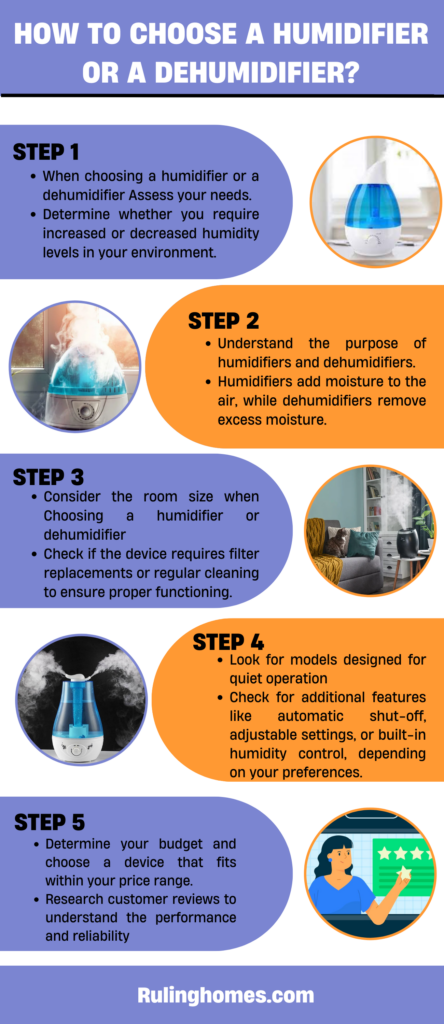The basic difference between a humidifier and a dehumidifier can be described by explaining four key points of both appliances, which include:
- Purpose
- Benefits
- Operations
- Ideal Conditions
Table of Contents
Purpose
Humidifier: A perfect humidifier adds moisture to the air, increasing humidity levels. It is commonly used in dry environments or during the winter season to combat dry skin, soothe respiratory issues, and provide overall comfort.
Dehumidifier: A dehumidifier removes excess moisture from the air, reducing humidity levels. It is typically used in humid climates or spaces prone to dampness to prevent mold growth, minimize allergens, improve air quality, and protect belongings.
Benefits
Humidifier: Benefits of using a humidifier include relieving dry skin and nasal passages, reducing congestion, minimizing the risk of airborne viruses, and preserving wooden furniture and musical instruments that can be negatively affected by low humidity.
Dehumidifier: Dehumidifiers offer advantages such as preventing mold and mildew growth, controlling dust mites and allergens, improving respiratory conditions for individuals with allergies or asthma, and protecting electronics and sensitive materials from excess moisture damage.
Operations
Humidifier: Humidifiers work by dispersing water vapor into the air through various methods, such as evaporation, ultrasonic vibrations, or steam generation. The moisture is released into the environment, increasing humidity levels.
Dehumidifier: Dehumidifiers employ different techniques to extract moisture from the air. The most common type, refrigerated dehumidifiers, uses a cooling system to condense and collect water vapor, which is then drained or collected in a reservoir.
Ideal Conditions
Humidifier: Humidifiers are most beneficial in dry environments, during cold seasons when heating systems can deplete moisture, or in arid regions where humidity levels are naturally low.
Dehumidifier: Dehumidifiers are typically used in humid climates or spaces with high moisture levels, such as basements, bathrooms, laundry rooms, or areas affected by water leaks or flooding.
How to choose a humidifier or a dehumidifier?
Choosing humidifier or a dehumidifier is a simple and easy process. You just need to follow these basic guidelines while choosing a humidifier or a dehumidifier.
Assess your needs: Determine whether you require increased or decreased humidity levels in your environment.
Understand the purpose: Humidifiers add moisture to the air, while dehumidifiers remove excess moisture.
Consider the room size: Choose a humidifier or dehumidifier that can adequately cover the square foot area of your space.
Evaluate maintenance requirements: Check if the device requires filter replacements or regular cleaning to ensure proper functioning.
Consider noise levels: Look for models designed for quiet operation, especially if noise is a concern.
Check for additional features: Look for features like automatic shut-off, adjustable settings, or built-in humidity control, depending on your preferences.
Set a budget: Determine your budget and choose a device that fits within your price range.
Read reviews: Research customer reviews to understand the performance, reliability, and user experiences of different models.
Conclusion
The difference between humidifiers and dehumidifiers lies in their purpose and operation. A humidifier adds moisture to the air, increasing humidity levels, while a dehumidifier removes excess moisture, decreasing humidity levels.
Humidifiers are used to combat dryness, improve respiratory health, and protect certain materials. At the same time, dehumidifiers help prevent mold growth, reduce allergens, and create a more comfortable living environment in humid conditions.
The choice between a humidifier and a dehumidifier depends on the specific needs of your indoor environment, whether you require increased or decreased humidity levels.
By understanding these differences, you can make an informed decision and select the right device to optimize indoor humidity for your comfort and well-being.

I grew up on a small farm in New Jersey. We had a big family because my parents, my uncles and aunties all were living together on this farm so, you can imagine, it was always over crowded with people. But living in farm was really great because we had to do everything on our own and I learned so many things from my parents and uncles and aunties and that is where I found my passion for fixing things, whether it is renovating or designing, I was always there. Read more

